Arapça Örneği Üzerine Odaklanarak Çeviri Tarihinde Geçmişten Günümüze Eşdeğerliliğin Kökleri
Kaynak metin (ST) ile hedef metin (TT) arasında eşit değere veya eşdeğerliğe ulaşmak, her çeviri girişiminin tartışmasız hedefidir. Bununla birlikte, bu hedef hala elde edilmesi çok zor bir hedeftir çünkü ister bir yaklaşım, ister bir ilke veya kuram olarak ele alınsın, eşdeğerliliğin tanımı tam olarak hiçbir zaman yapılamamıştır. Bu gözden geçirme makalesi, eşdeğerlik kavramını çeşitli çeviri kuramları üzerinden, esas olarak 1950'lerden sonrasına odaklanarak izlemeye çalışmaktadır. Çalışma, eşdeğerliği kuramsal bir yöntem olarak çeviribilimcilerin gözünden ele almaktadır. Verilen örnekler Arapçadır, çünkü Arapça, kökleri ve gelişimi söz konusu olduğunda İngilizceden tamamen farklı bir dildir ve bu, herhangi bir çevirmen için eşdeğerliğe ulaşmayı daha da zorlaştırır.
Anahtar Kelimeler:
Translation History, Equivalence, Source Text, Target Text, Arabic
Roots of Equivalence in Translation History Till The Current Times With Concentration on Arabic as an Example
Achieving equal value or equivalence between the source text (ST) and the target text (TT) is the key aim of every translation attempt. However, since equivalence evades a concrete definition, this can complicate the translation process. This review article attempts to track the concept of equivalence through the various translation theories, focusing mainly on the 1950s onwards. Rather than viewing equivalence as an approach or principle, the study investigates its use as a theoretical method. To best illustrate the complexities of this task, this study focuses on equivalence in Arabic-English translation, given the lack of commonality in the roots and development of these respective languages.
Keywords:
Translation History, Equivalence, Source Text, Target Text, Arabic ,
___
- Allen, R. (2010). The happy traitor: Tales of translation. Comparative Literature Studies, 47(4), 472–486. https://doi.org/10.5325/complitstudies.47.4.0472
- Al-Manfaluti, M. (2020). The Complete Works. Dar al-Kitab al-Arabi.
- Baker, M. (1998). Encyclopaedia of translation studies. Routledge.
- Baker, M. (2018). In Other Words: A Coursebook on Translation (3rd ed.). Routledge. https://doi.org/10.4324/9781315619187
- Benjamin, W. (2000). The task of the translator: An introduction to the translation of Baudelaire’s “Tableaux Parisiens.” In Venuti, L. (Ed.), The translation Studies Reader. Routledge.
- Birdwood-Hedger, M. (2007). Tension between Domestication and Foreignization in English-language translations of Anna Karenina. [Unpublished manuscript].
- Bowles, P. (1973). “Introduction.” For Bread Alone. Mohamed Choukri. Paul Bowles (Trans). Saqi Books. Carford, J. C. (1965). A Linguistic theory of translation. Oxford University Press.
- Choukri, M. (1972). Al-Khubz al-Hafi. Saki Books.
- Conway, K. (2022). Anthropology and cultural translation. In Zanettin, F., & Rundle, C. (Eds.), The Routledge Handbook of Translation and Methodology (1st ed.). Routledge. https://doi.org/10.4324/9781315158945
- Davies, j. D. (2006). Memories in translation: A life between the lines of Arabic literature. The American University in Cairo Press.
- Gewaily, M. (2007). Explicitation and implicitation in the English translation of Mohamed Choukri’s For Bread Alone. Prude University.
- Guessabi, F. (2013). The cultural problems in translating a novel from Arabic to English language: The Algerian novel. Arab World English Journal, (2).
- Jakobson, R. (1971). On linguistic aspects of translation. Volume II Word and Language. De Gruyter Mouton.
- Janson, T. (2002). Speak a short history of languages. Oxford University Press.
- Karoubi, B. (2015). A critical account of the evolution of translation theories in the West between the seventeenth and nineteenth centuries. Translation Review, 91(1).
- Kumar Das, B. (2005). A handbook of translation studies. Atlantic Publishers.
- Long, L. (2007). History and translation. In Kuhiwczak, P. & Littau, K. (Eds.), A companion to Translation Studies. Cromwell Press.
- Luz, S. (2004). Web-based corpus software. Trinity College.
- Munday, J., Ramos Pinto, S., & Blakesley, J. (2022). Introducing Translation Studies: Theories and Applications (5th ed.). Routledge. https://doi.org/10.4324/9780429352461
- Nabokov, V. (2000). Problems of translation: “Onegin” in English. The Translation Studies Reader. Venuti, L. (Ed.). Routledge.
- Najjar, M. (1984). Translation as a correlative of meaning: Cultural and linguistic transfer between Arabic and English. Indiana University.
- Nida, E. (2001). Contexts in translating. Benjamins Publishing.
- Pickthall, M. W. (1930). The meaning of the glorious Quran. Madhur Sandesh Sangam.
- Pym, A. (2004). The moving text: Localization, translation, and distribution. Benjamins Publishing.
- Pym, A. (2008). On Toury’s laws of how translators translate. In Pym, A., Shlesinger, M., & Simeoni, D. (Eds.), Beyond descriptive translation studies investigations in homage to Gideon Toury. Benjamins Publishing.
- Pym. (2017). Humanizing Translation History. Hermes (Århus, Denmark), 22(42), 23–48. https://doi.org/10.7146/hjlcb.v22i42.96845
- Quine, W. V. O. (2000). Meaning and translation. The Translation Studies Reader. Venuti, L. (Ed.). Routledge.
- Reiss, K. (2000). Towards a general theory of translational action: Skopos theory explained. Routledge.
- Salih, T. (1988). Season of migration to the north (D. Johnson-Davies, Trans.). Review Books.
- Vinay, J. & Darbelnet, J. (2000). A methodology for translation. In Venuti, L. (Ed.), The Translation Studies Reader. Routledge.
- Başlangıç: 2021
- Yayıncı: Selçuk Üniversitesi
